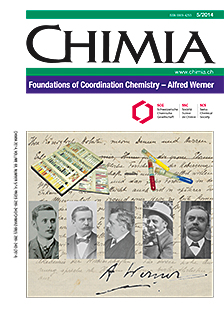Stereochemistry of Coordination Compounds. From Alfred Werner to the 21st Century
DOI:
https://doi.org/10.2533/chimia.2014.297Keywords:
Chirality, Coordination compounds, Stereochemistry, Stereoselectivity, Werner, alfredAbstract
: As a contribution to the scientific symposium, November 22nd, 2013, commemorating the Nobel Prize awarded to Alfred Werner in 1913, a presentation of the development of stereochemistry of coordination compounds during the past 120 years was given. Stereochemistry was fundamental to Werner's theory of coordination compounds. After Werner's death in 1919, stereochemistry in this field did not progress much further for almost 20 years, but then developed continuously. It was realized that stereochemical features of elements showing coordination numbers larger than four are responsible for an almost unlimited number of stereochemical possibilities, thus opening a molecular world of new structures. In the beginning of the 21st century, interest in the field rose again considerably, mainly due to the potential of stereoselective catalysis, and the self-assembly of supramolecular structures. An end of these developments is not in sight. Here an abbreviated version of the lecture is given. A PowerPoint® file, or a video of the presentation, can be downloaded.Downloads
Published
2014-05-28
Issue
Section
Scientific Articles
License
Copyright (c) 2014 Swiss Chemical Society

This work is licensed under a Creative Commons Attribution-NonCommercial 4.0 International License.
How to Cite
[1]
Chimia 2014, 68, 297, DOI: 10.2533/chimia.2014.297.







